House Diary: Ostara
For readers unfamiliar with my saga, I’m an inveterate celebrator of the seasons. Although raised as a fundamentalist Protestant, what my parents truly inculcated in me was a love of nature and the wilds. Those few precious hours between Sunday morning school and church services and Sunday evening prayer meetings were often spent in the backroads and byways of the Poconos, identifying the local flora and fauna, which was where my spirit truly soared.
So pagan practice was something I gravitated to naturally when I threw off the confines of my upbringing. But as a city dweller for 35 years, without regular access to the fields and woods of my boyhood, I’ve had to recreate those spaces indoors, and I decorate extensively season to season, using the Wiccan Wheel of the Year as my model and faux or artificial elements as my tools. These days I have no faith, terming myself a “lapsed Pagan”, but I still enjoy the rituals of my maturity and the traditions of my youth when holidays roll around.
So it is that I celebrate Ostara, named for the Teutonic deity Eostre, a goddess of spring and the dawn who was reputed to transform herself into a hare and had a fondness for distributing brightly colored birds’ eggs. Sound familiar? It should, for Eostre is the root of the Christian term “Easter”, and the cultural associations are obvious. Ostara’s day is the Vernal Equinox, but being ecumenical, I also observe Easter, with a dash or two of Passover thrown in, and although I’m Pennsylvania Dutch by birth, I don’t mind a good cultural appropriation of corned beef and cabbage with colcannon when St Pat’s takes center stage.

That’s me, in my smart new Easter bonnet, hunting for dyed eggs in my Aunt Rebecca’s backyard, age 3
Now that I’ve moved back to the ancestral estate (I’m a Leo, so cut me some slack on this designation for my 100×150 foot plot), I get to indulge once again in my first spiritual love – a true connection to the soil. This post will highlight some of the traditions and cuisine with which I celebrate spring, as well as the delights of my garden.
Being not one for yard work of the cutting grass variety, and valuing my privacy (especially with a new housing development springing up in the formerly farmed field behind the house) last summer I had the sod ripped out from the side and back yards and enclosed them with an 8’ fence. In the fall I hired a crew to plant 500 bulbs and 5 dozen daylilies, and we’re starting to see those efforts pay off.
The earliest blooms were a bit disappointing. Not only were these tender teeny bulbs too heavily mulched by my team (despite my admonishments), causing them to struggle, but the rabbits decimated many varieties. I may appreciate Ostara, but her minions, less so!

Bright-gold Eranthis, or winter aconite, is one of the first to bloom in late winter; its close botanical relation to the buttercup is easy to see
Among those that thrived were Eranthis, the winter aconite, with its bright golden cups atop jagged-frilled leaves. Paired with Galanthus, the noble snowdrop, they make a stunning show in the late winter garden, a first harbinger of spring. Or will in a few years, once they’ve matured.
The rabbits also spared the blooms of the snow crocus, though they seem to have considered their striped sword-like leaves a delicacy. Leaf growth is vitally important to any bulb plant’s long-term health and ability to set blooms the following year; I’m hoping this setback will be temporary and these charming beauties will return next spring, after extensive rabbit-proofing of the fence.
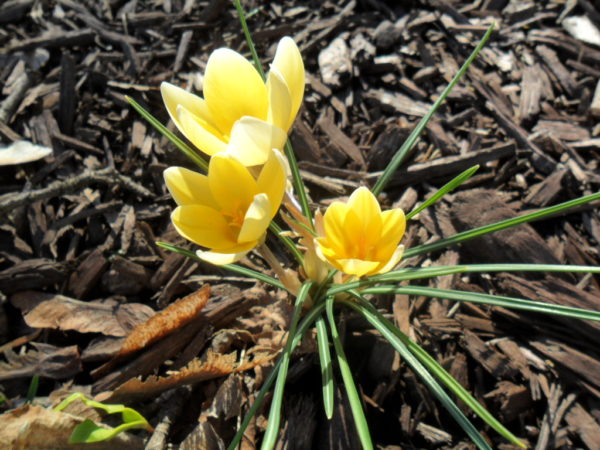
A buttery cluster of snow crocus, blooming right on the heels of snowdrop and aconite; the mix I purchased also included white, pale blue and bright yellow varieties
The twilight marauders completely decimated my Scilla, commonly known as squill, both blue and white-flowering varieties, stripping it leaf, stem and bud, leaving me with scant hope of their resurrection next year. But perhaps I’ll be pleasantly surprised. Although closely related, they didn’t bother the Siberica alba, which is now in full flower. These diminutive darlings send up 3-4” spikes studded with star-like white blooms, and usually come into flower late March or early April here.
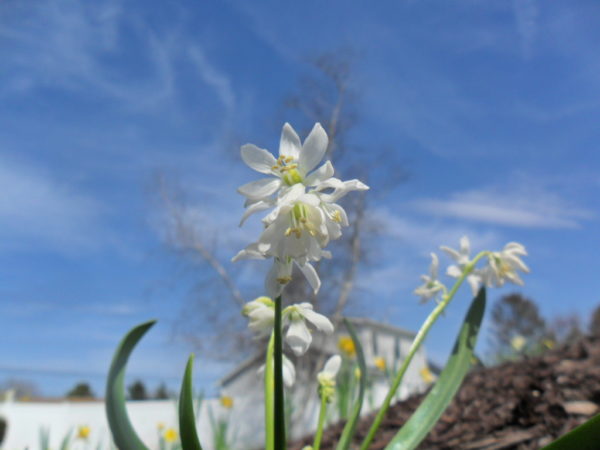
Siberica alba was thankfully spared by the rabbits, as this clump attests; these have been in bloom for over a week, and continue to thrust up new budded stems
But now is the time of the bluebell! Muscari, also known as grape hyacinth, comes in a range of blues to white, and this year, in addition to the familiar deep blue so ubiquitous in the kitchen garden, I have planted a pale blue variation and a tricolor, which blushes from pure alabaster at the tip of each bloom to azure at its base. How I forgot to order the white ones I can’t imagine, but it’s a deficiency I’ll rectify this fall. The rabbits ate some of these leaves, but left enough for the plants to store energy for next year, and thus far, haven’t touched the blooms, which have been prolific.
The Narcissus family was the main focus of my purchases last autumn, and thankfully, rabbits disregard these, as do deer. So the early mini daffodils, Tete-a-Tete and Jetfire varieties, went unmolested and put on a spectacular show for a first season. Tete-a-Tete are smallest and earliest, pure yellow and prolific bloomers that are often ready in time for the Equinox; the particular species I happened to get showed as many as three blossoms per stem, multiple stems per bulb, a real treat! Jetfire is a little larger and blooms a little later, slightly windswept yellow petals with a bright orange cup. Their bloom times overlap, so I planted them together to encourage a longer season, and highlight their contrasts.

“Blue”bells now come in a range of colors, including this stunning tricolor version, just coming into maturity now
The standard-sized daffodils were next to come into flower, and aren’t done yet! I purchased a mix of early, mid- and late-season varieties to extend the show a full two months. The latest to flower, Leucojum, with five to seven downturned bell-shaped white blossoms per stem, whose petals sport small green dots at their tips, won’t be fully in bloom until Beltane, May 1, ending the narcissus season.
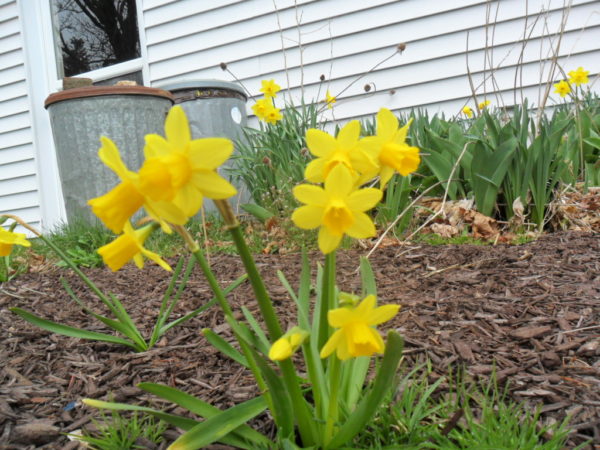
The diminutive Tete-a-Tete was a standout in the early spring garden, even with a backdrop of garbage cans; is that 8 blooms I spy, from one bulb? Outstanding!
Some of these earlier varieties put in poor performances this spring, sending up just one bloom per bulb. I paid for top-size bulbs, which should have produced better, even in a first year, so I suspect Breck’s cheated a bit on what they sent me. Nevertheless, they’re healthy, getting plenty of sun, and by next spring I hope for at least three blooms per bulb, with continuing expansion season to season. In five years the sand mound will be covered with them!

Jetfire’s bright orange cups are further accentuated by its windswept petals; a bit taller than Tete-a-Tete and blooming just after, it makes a good contrast with its smaller sister
One variety did extremely well, however, but despite my Virgo Moon, the name escapes me. It was alleged in the catalog to be a double flower with an almost hot pink inner frill; I would say in practice it’s more apricot in color, but still very lovely. They performed superbly, with as many as 8 blooms per bulb.

This pink-frilled charmer, whose name eludes me, was one of the best performers of the season, gorgeous in a bed of a dozen
A true joy of the season and not to be forgotten are the tree blossoms, which come in a dizzying array of green, yellow and red tones before their leaves mellow to the flat ubiquitous green of summer. I’d often missed this brief phase of arboreal splendor in my biweekly visits to my father over the years, but now that I’m on site 24/7 (thanks to coronavirus) I get to watch the stunning transformation, as buds swell, burst and flower. The maple is a particular favorite, with its heads of brilliant chartreuse blossoms. But there’s a special place in my heart for the snaky lemon catkins of the birch; there have been birch (which is ruled by Leo) at every property where I have ever lived, and the triple trunk clump in the backyard was one I brought home in a bucket from the field behind the house when I was ten.
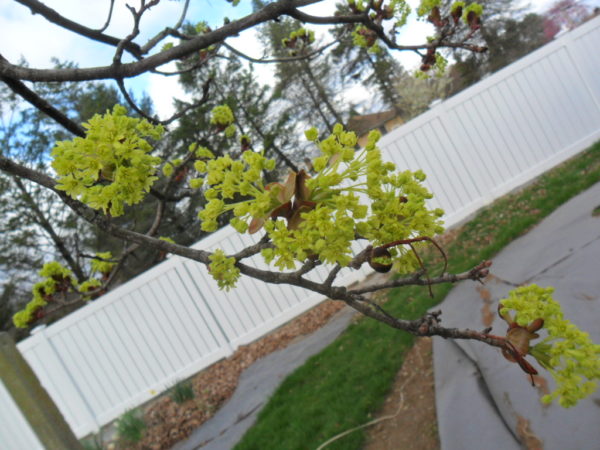
A study in chartreuse: maple blossoms swell, burst and explode in riot of lime-colored floral fireworks
Out front (mom always said put your best foot forward!) there’s a large electric-yellow forsythia that is just now past its prime of bloom, which I’ve been cutting and forcing indoors for weeks. And there’s new life in the spiraea hedge which my father kept resolutely clipped into a four-foot-high rectangular box, and subsequently hadn’t blossomed in years. I let it grow out last summer, and its exuberance at being allowed to flower again has been apparent. And next on deck will be the lilacs, including a hard-to-find deep burgundy variety grown from a slip taken from a large lilac stand my grandparents had.
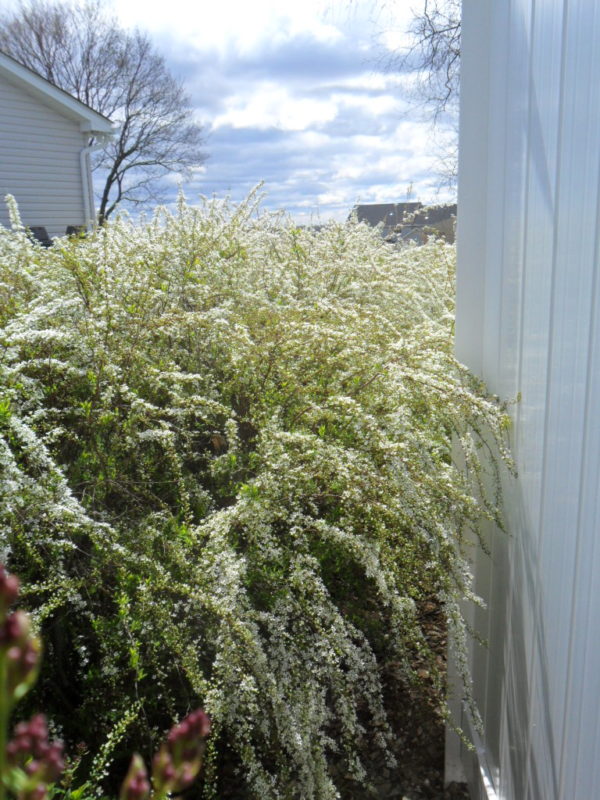
The spiraea hedge was at long last released from my father’s topiary bondage, and has thanked me with a vivid display of snowy white
I’ve always enjoyed entertaining, and keep a seasonal focus there, too. This year, given social distancing restrictions, I’ve had a solitary celebration, with the table set for one. Most of my decorations also went unpacked, due to the circumstance of the move at the same time, but a few leprechauns, shamrocks, rabbits and eggs have adorned the new space.
My Ostara dinner consisted of an eggy quiche with bacon, mushrooms, leeks, cheddar and parmesan, accompanied by garlic sautéed asparagus, a roasted beet salad with chive, horseradish and mustard, and a simple cole slaw enrobed with my grandmother’s sour cream dressing, bright with red wine vinegar.

Ostara dinner was a solitary one for me this year, but I took advantage of the occasion to indulge in some of my seasonal favorites
Of course the starter, as always, was toasted bagels with spreads – scallion- or smoked salmon-flavored cream cheese, and whitefish salad. And naturally there were the de riqeuer colored hard-cooked eggs. As a child I loved to sit with my mother in the kitchen and paint these with Q-tips dipped in food dye, the eggs so hot from the pot they had to be held with paper towels, which if you weren’t careful, smeared your oh-so-patiently-wrought design. These days I go for a simpler preparation, and dye them as they cook in pots of colored water. But my favorites are still the bronze-rust beauties my grandmother taught me to make, by placing a few onion skins in the pot, hoarded from culinary efforts over the prior year.

Eggs dyed rusty-bronze with bits of onion skin added to the pot have been a fixture of my Easter celebrations since my grandmother taught me how to do them as a child
I won’t be cooking anything special for Easter this year, by myself, but when dad was alive we always had a ham, typically with a honey/mustard/fig jam glaze, au gratin potatoes, pearl onions and peas, Harvard beets, and curly endive with hot bacon dressing. Now that last I’ll miss!
As a kid, my grandmother fed a houseful, serving dandelion which my grandfather had harvested in Nazareth Park, right behind their home, in lieu of the endive. But there’s far too many dogs walked in that park now for me to feel comfortable with its offerings as a side dish. She also featured fried ham steaks (which were a LOT more work than roasting a ham!) with fried eggs. It was my job, with my cousin, to ask of the 15-20 guests how many eggs they wanted and report to Nana with the total. Everybody wanted at least two – you do the math!

Ten-year-old me, mugging for the camera between my cousins Renee and Gayle, while the licorice-eyed bunny cake awaits its fate
Frying three dozen+ eggs to order isn’t everyone’s cup of tea, but Nana loved feeding her crowd of extended family and friends. Mashed potatoes, creamed corn and candied yams completed her menu – topped off with the traditional rabbit-shaped white cake, frosted in soft buttercream, with licorice jellybean eyes. My cousin and I still squeal about how “gross” it was when our elder relatives topped their potatoes with the dandelion and hot bacon mixture. “It all goes in the same stomach!” they’d jeer.
I like to think I’ve maintained that family tradition of ostentatious hospitality, though as I sit here now contemplating my plate of dyed eggs turned into an egg salad and deli ham sandwich, that time seems far away indeed. But there’s always next year.
Best to all in these COVID-trying times! And Happy Spring, whatever you celebrate!


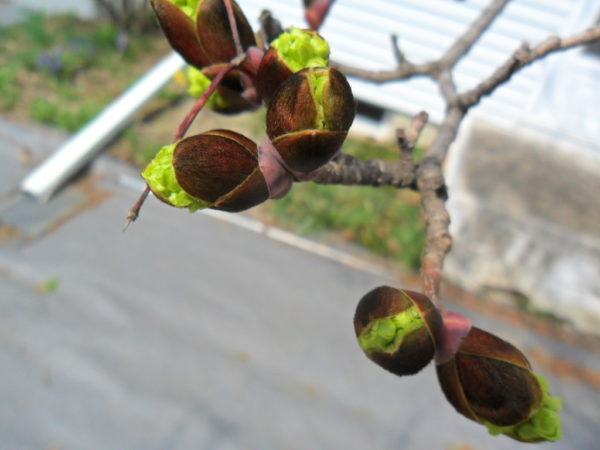


4 comments, add yours.
Ariel Harper Nave
Lovely–so good to hear you thriving in your new/old homestead…a bright and blessed Season to you, Alex!
xoxo
Ariel
Sue Kientz
Love the inside peak into your world, Alex! As a former Allentonian (now a Californian), I identify with so much of your memories. My mom was also PA Dutch, from Hamburg. But I admire your knowledge of all the flower names. I have wanted to really know and remember the names of flowers, trees and stars, but have only succeeded in a small portion of each. Out here in California I have a yard and lots of flowers from the nursery, some of which have persisted in flowering for 5 years! The requirement I have with flowers: pretty, colorful, and perennial. Lastly since the gardener we have has been kept away by a spate of rain, and we have had persistent rain, we have wildflowers on the ground all in the back. If he stays away much longer, we will have a Amazon Rain Forest.
Enjoy the house and abundant nature, and happy Spring!
Karen
Thank you for sharing all of this with us. Love the pictures… of family and flowers. You were a dapper little boy. What sweet memories… and more memories to make once we get through this. Stay safe and well.
patricia
What a lovely sharing Alex and to know you have a love of the garden in spring is heartwarming for this garden love who finally created an English cottage garden to remind me of my English home, in the Australian new England region which has four lovely seasons most years. Wishing a Blessed and peaceful Easter Day
patx